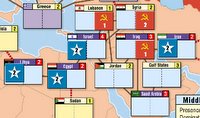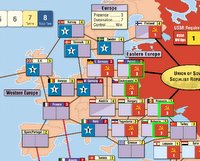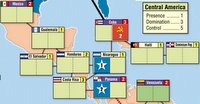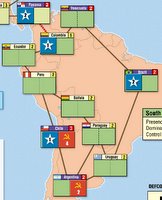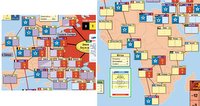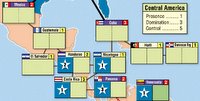A tentative opening from both sides.
The Union places a fort in Harper's Ferry, moves the AoP to Frederick, while putting an SP in Baltimore to protect our supply line to DC, adds PCs in Tennessee (Pro Union Secessionist in Tennessee) and ups the AA modifier by 2.
The CSA adds 3SPs, places two PCs in Kentucky, and forces Union SW down by 5 (Stop the War).
Summer 1861
The Union continues to lay the groundwork for future action by securing its borders. A fort is placed in Frederick, and a new (and mis-named) Army of the Missouri is created in DC, under the command of McLellan. This Army will not be used for offensive purposes, but with McLellan's defensive modifier, they have a decent chance to make some intercepts and cause some casualties. Plus, the two armies will help protect the Union against politically-motivated rash movements towards Richmond.
The CSA revel in Draft Riots, which sap Union strength and continue to place PCs in Kentucky.
In the first offensive action of the war, Pope and Burnside, commanding 6CUs in Cairo, attack Columbus, KY. The CSA does the better fighting, but the garrison is overwhelmed all the same, due to numerical superiority, and the fort in Columbus is destroyed.
The Union also tightens its blockade, while the CSA places a fort in Manassas to guard the approaches to Richmond.
The USA launches a Minor Offensive. Rosecrans sails from Cincinatti and takes the fort at Dover while Banks advances with 3SP to restore order in Kentucky. Mud hampers his march, however, and his effort is less than successful, though enough to prevent Kentucky joining the CSA.
Strategic Will
USA: 98+
CSA: 95-
Blockade: 1
AA: 2
Fall 1861
Contraband of War enables the Union to remove SPs from Manassas and Nashville, forestalling CSA plans to create armies in those spaces (by dropping them to 4SP). The CSA uses what leverage it can gain from cotton to add SPs to its own effort.
Baltimore Revolts is in the Union hand, so the 1SP from Baltimore joins the AoM in preparation for an AA against Forts St Phillip/Jackson lead by Admiral Foote. The assault ends successfully with 2 Union SPs in the coastal fort. With the Mississippi vulnerable, the CSA places torpedos at key points. But it is not sufficient to prevent the Union from gaining control of the Mississippi and cutting the CSA in half.
While the CSA continue to move SP to more strategic locations, the Union tightens the blockade even further.
The CSA send Pemberton with a small force into Kentucky, as far as Lebanon, to attempt to bring the state into the CSA fold. The Union responds by attacking the remaining forces in Nashville, cutting Pemberton off from supply, in an attempt to thwart his efforts.
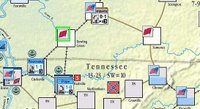
Strategic Will
USA: 97+
CSA: 80-
Blockade: 2
AA: 2
Spring 1862
After a winter of training and wheedling by Lincoln to "do something", McDowell starts 1862 by attacking Manassas with the AoP (we're unlikely to win, but attrition will diminish the starting SP in the AoNV, and Lee is there but not yet a commanding general, so maybe we get lucky and kill him). The forts, however, prove too daunting a task and the AoP fails in its assault.
On the CSA side, having distinguished himself at Manassas, Lee forms the force into the Army of Northern Virginia. On the Union side, despite the loss, a group of soldiers from Wisconsin distinguish themselves and are dubbed "The Iron Brigade".
Burnside gathers up the scattered Union forces in Northern Tennessee and prepares to form an Army of his own, the Army of Tennessee. While he is busy with logistics, Burnside leaves Nashville unoccupied, enabling Wheeler's cavalry brigade to return to town and reassure the population. Meanwhile Johnston moves to Clinton, TN to quell the Union sympathizers there and re-open supply lines into Kentucky.
Faced with a newly supplied Pemberton, Burnside wastes no time advancing his Army to Lebanon to attack Pemberton. Once again, the CSA gives better than they get, but are numerically unable to forestall the AoT which brings Bowling Green, Lebanon, and Somerset back under Union control.
Burns, however, fails to protect his supply lines, which become Wheeler's next target as he moves his cavalry to Dover. At the same time, Johnston and Polk bring their forces together at Tullahoma, where Johnston forms the Army of Tennessee to oppose Burnside.
Union forces occupy Louisville, which will re-open Burn's supply lines and will be enough to insure that Kentucky gets the message and joins the Union.
In the East, McLellan dispatches two amphibious forces from his army in a joint operation against the CSA Fort Pulaski and Fort Gadsen. Both assaults are successful, further tighetning the Union grip on CSA shipping.
Strategic Will
USA: 106+
CSA: 70-
Blockade: 2
AA: 2
Summer 1862
With Jackson and Longstreet now capable of marauding around the map, the Union fortifies Pittsburgh to hamper CSA raiding. With Kentucky now in the Union fold, and with the CSA unable to cross the rivers from Kentucky, Burnside moves the AoT's base of operations to McKenzie. From here he threatens Memphis and can fight the CSA AoT.
In the Eastern Theatre, McDowell takes his AoP to Winchester and Strasburg in an attempt to catch Johnson before his force can join the AoNV. But Johnson proves far too wily, and retreats in good order through Strasburg and finally into the forts at Manassas. Needless to say, Lincoln is not pleased with McDowell allowing him to slip away without a fight.
His displeasure is increased when the newly-strengthened AoNV leaves Manassas to attack the AoP. Luckily for McDowell, the result is fairly inconclusive, although he is driven back to Winchester.
After a brief rest in McKenzie, Burnside gets his forces moving again, striking out at Van Dorn, who is defending Memphis. The result is never in doubt.
McLellan, itching for action in DC complains loudly that dysentery is cripping his inactive forces. Lincoln is unmoved. Meanwhile, Union successes begin to convince the good folks of Missouri that the Union cause is just...or at least likely to prevail. Pro-Union rallies occur in Greenville, MO.
Spurred into action, the CSA launches a series of actions across the map. J Johnson leaves the AoNV and returns to handle the defenses at Manassas. A division moves from Weldon to Richmond to increase defense of the capital. And Johnston leads his AoT overland to attack Burnside and his AoT.
The two massive armies clash at Memphis and the CSA proves too difficult for the Union, which retreats with heavy losses to Humboldt. The CSA also suffers heavily, though they have better facilities at Memphis in which to recover.
McLellan continues to complain loudly that the Union's best general is being left to rot, so Lincoln assigns him the task of organizing another series of Amphibious Assaults, this time against Columbus, GA and Fort Sumter. The force lands unopposed at Columbus, but the assault on Fort Sumter is turned back.
Lee, having secured his lines of communications, strikes the AoP at Winchester. The AoP offers stiff resistance, however, and Lee is forced to retreat.
Strategic Will
USA: 103+
CSA: 65-
Blockade: 2
AA: 2
Fall 1862
Having failed to take Fort Sumter on his own, Lincoln decides to assign Admiral Farragut to assist McLellan. Farragut's brilliant plan not only takes Fort Sumter, but also lands Pope and a small force in the port of Charleston as well.
CSA General Thomas "Stonewall" Jackson attacks Joe Hooker in Columbus, GA where he is threating to form an Army. Hooker manages to hold the city briefly, however a follow-up attack forces him to evacuate the city and return to DC.
Despite the minor setback, the Union effort is bolstered by the response to a call for volunteers and by more pro-Union rallies in Missouri, this time in Rolla. Even the sighting of another CSA Ironclad near Vicksburg can't dampen Union enthusiasm.
Burnside rouses the AoT from its camps in Humboldt and marches on Memphis, determined to re-take the city. Johnston proves too tough an opponent, however. At the height of the battle, CSA general Pemberton is killed leading the charge that sweeps the Union from the field. Johnston attempts to follow up by sending Morgan's cavalry to cut the AoT's supply, but Burnside intercepts Morgan, and his cavalry force is decimated.
Following on his success at Charleston, Pope's command is once again sent on an Amphibious Assault, this time to Sabine City, TX, where he lands successfully against light opposition.
General Jackson now leads his forces towards Kentucky, hoping to relieve pressure on Memphis. Unfortunately the degradation of CSA rail lines and supply problems which leave his men's haversacks empty hamper the march and he is only able to make it as far as Kingston.
Strategic Will
USA: 95-
CSA: 59-
Blockade: 2
AA: 2
Spring 1863
Pope's landing force in Sabine City is reinforced heavily and General U.S.Grant sent there to form the Army of the Cumberland, while Stonewall Jackson drives his force through the long winter until they reach Somerset by Spring.
Burnside moves his Army to Franklin, where he can keep an eye on Jackson, but maintain the threat to Memphis. Meanwhile, a small force under Van Dorn is shipped to Jackson, MS to keep an eye on Grant. He doesn't have to wait long for news, as Grant move his army forward aggressively, converting Shreveport into a supply base on the way before dispatching a small garrison defending Monroe.
Lincoln seizes on the Battle of Monroe, which seemed only a minor victory at the time, to make his Emancipation Proclamation.
Burnside, keeping one eye on Jackson, begins to exert control over ever larger areas of Tennessee while moving towards eastern Tennessee where he can get himself astride Jackson's supply lines. Grant drives his small Army forward again, taking Jackson and Vicksburg from CSA garrisons.
Grant pauses just long enough to survey the situation. His relentless efforts have dwindled his forces, but he has eliminated all opposition that could threaten him through Vicksburg. He decides to strike out north, taking Little Rock from its tiny garrison and threatening Memphis from the West and East. Maybe he can succeed where Burnside failed during the Summer Campaign months?
Texas, after Grant's march from Sabine City, becomes the first CSA state to give up the cause.
Strategic Will
USA: 105+
CSA: 27-
Blockade: 2
AA: 2
Summer 1863
Grant's newly reinforced Army strikes northward from Little Rock to eliminate Price's small force, which has stayed on the Arkansas/Missouri border since the War's start. This secures his flank and converts areas of Arkansas to the Union side. His offensive ends in Little Rock, where it began.
AP Hill moves into the void left by Grant, moving his force from New Orleans to Vicksburg.
Convinced that Jackson's march is just a diversion and determined not to let Grant have the glory of taking Memphis, Burnside moves the AoT back towards Memphis, through Southern Tennessee, converting areas as he goes. When news of Burnside's departure reaches his camp in Somerset, Jackson moves further North, settling in Louisville.
A fierce battle rages behind the scenes over the objectives for Grant and Burnside, and when the dust settles, Lincoln commands Burnside to give up command of his precious cavalry regiment, in favor of sending it to join Grant who will assault Memphis. The CSA AoT will be pinned in Memphis by the threat of Grant and the cavalry-less Burnside is given leave to pursue Jackson in Kentucky. Complaining bitterly, Burnside nonetheless does as as ordered and advances to Lebanon, where Jacskon intercepts his force, and deals a blow to both the AoT and Burnside's pride, confirming for Lincoln that he chose the right man for the job of taking Memphis.
Surprisingly, however, Johnston moves the AoT away from Memphis, conceding it to Grant and marches forward to Paducah, KY. Grant, taking pains to leave enough force behind to convert Arkansas, takes Memphis without a fight, ending his march in Humboldt.
Back in DC, McLellan's incessant whining finally gets to Lincoln who orders him "Forward to Richmond". McLellan balks, saying he needs 6 months and 150,000 more men, but Lincoln is adamant. Unfortunately, the argument spills into public and Lee is alerted to McLellan's plans. He lays a trap for him in Manassas and pummels the AoM back to DC with heavy losses almost as soon as it starts its march. Even the loss of Johnson in the battle is not enough to sour the jubilation of victory, which culminates in recognition of the CSA by Brazil.
The jubilation, however, is short-lived. Grant moves his AoT from Humboldt, surrounds Johnston's AoT, and, after winning a narrow victory on the field of battle, destroys the Army utterly when it can find no path to retreat.
Lee, sensing a shift in the winds again, gathers forces from every available garrison and launches an attack against the AoP, dealing a second USA Army a serious blow in a single campaign!
It's a glorious victory and bouys the CSA spirits, at least until news arrives from the West that both Arkansas and Tennessee have left the Confederacy.
Strategic Will
USA: 90-
CSA: 7-
Blockade: 2
AA: 2
Fall 1863
With Tennessee, Arkansas, and Texas converted, Grant sets his sights on Mississippi, moving his force south through Panola to Granada. Forrest's cavalry brigade shadows him, to Memphis, threating to cut of his supply. Grant is undaunted and continues moving southward, where he catches up with AP Hill, destroying his force in Vicksburg.
The CSA hastily forms the Army of the West in Atlanta with AS Johnston back in command, despite his recent failures.
Grant continues to maraud through Mississippi, securing supply ports in Vicksburg and Grand Gulf, while the Army of the West marches north into Kentucky to join up with Jackson. Burnside, hoping to prevent them from joining forces against him, attacks Jackson, who is caught napping and loses his force. Emboldened, Burnside pushes forward and takes on the Army of the West at Somerset, but is forced to retreat to Lebanon when Johnston proves too tough for him.
Forrest moves to Panola, threating Grant's lines of communication once again, so Grant moves south, securing an alternate supply line through Mobile, before heading back into Mississippi to subdue the state, which eventually converts and drives CSA SW below 0.

